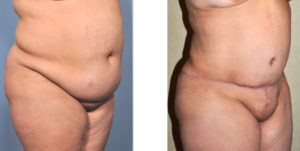Abdominal contouring is one of the most common body changes that many patients request. Pregnancy, fluctuations in weight and for some their own genetics make for this body centric area a focus of appearance and clothing wear. Numerous plastic surgery procedures exist for its modification but, in the end, they all involve methods to either reduce fat or tighten/remove skin.
At their most basic level, there are only three treatment options including non-surgical fat reduction/tissue tightening, liposuction and tummy tucks. Overshadowing these basic concepts lies a myriad of terminologies, often marketing-driven, that often makes the named procedure seem new or magically better. Often the procedure suggests and may even be explicitly stated that there is little to no recovery and limited after treatment downtime.
In an effort to help patients decide what treatment may be best for them, it is important to put them in perspective of ‘effort vs reward’. Once viewed from this approach, the options available for abdominal contouring will be better understood.
Non-surguical approaches to abdominal contouring are what I call ‘energy-based’ concepts. Whether it be radiofrequency, ultrasound or a variety of other energy types, the objective is to drive the energy past the skin (without burning it) and targeting the fat below. There can be endless debates about which type of energy is superior for this purpose but that is not the important concept to grasp about them. What is important to understand is that no non-surgical approach can produce a comparative result to surgery…period. All of their results will be less, many times far less, than what liposuction and tummy tucks can do. The reason to do them is to see whether the limited results they can produce are enough to avoid the need for surgery. In essence, non-surgical methods are all about ‘trying’ them to see what their comparatively limited benefits may be. For the devout non-surgical person, this will be the end of the pursuit regardless of the result. For the more open-minded surgical person, it is a qualifying treatment.

Tummy tucks remain the gold standard in body contouring when there is excess skin. No matter how a tummy tuck is done it is definitely invasive and will take more than a week or two for recovery. There are only two main tummy tucks for most non-bariatric surgery patients, a mini- and a full tummy tuck. These are based on the location of the large skin and fat cut out, a mini-tummy tuck being below the belly button and the full tummy tuck incorporating tissue removal above the belly button. The large amount of skin that is removed in a tummy tuck creates an unriveled amount of skin tightening that is largely permanent for most patients. Most tummy tucks need the adjunctive use of liposuction to either reduce the love handles where the tummy tuck doesn’t change or concurrently thin out some of the fat in the abdominal area which is not cut out. The combined tummy tuck-liposuction, also known as lipo-abdominoplasty, remains the ultimate body contouring procedure but its great benefits carry with it a significant recovery as well.
Dr. Barry Eppley
Indianapolis, Indiana



